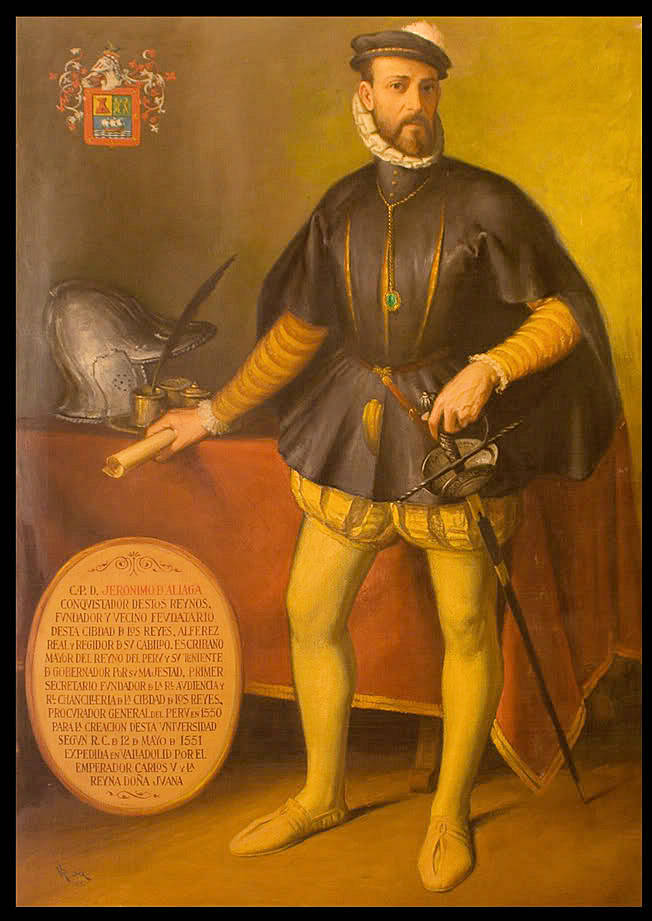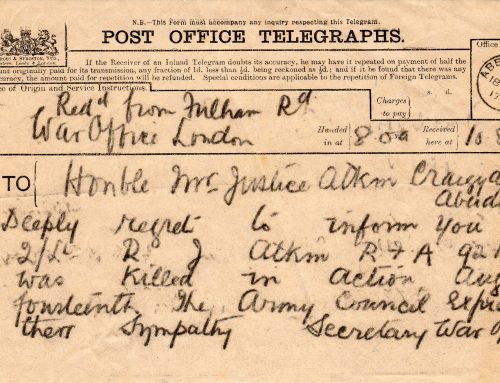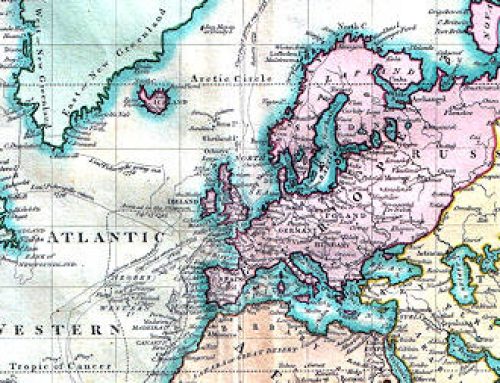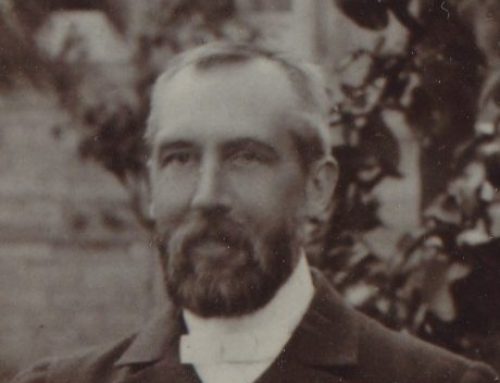In 1587 all settlers from the first English colony in the new world, Roanoke, had disappeared – probably from starvation. It would be 20 years before Jamestown was founded in 1617, the first English colony to survive in the New World.
The Spanish Empire dominates the New World in 1600
By contrast, in 1619, Lima had a university, printing presses, and a population of some 25,000. It was an important political and religious centre. Central to the Spanish Empire’s control over much of South America, Lima was founded in 1535, just 43 years after Columbus discovered the Americas.
Jeronimo de Aliaga, my 13th great-Grandfather, was central to the early foundation of Peru. As a young man he shared the perils of the conquest of Peru with Francisco Pizarro, and fought his way through the early civil wars which swept the young colony, and had enough capability to rise to administrative prominence in Peru.
Jerónimo de Aliaga and Pizarro
Jerónimo de Aliaga was born in Segovia in 1508, in the arid heartlands of Spain, not far from the royal city of Valladolid. By the age of 21 he found his way to Panama, joining in various expeditions mounted by the adventurers in Panama. Within a year, ‘with his horse and his weapons‘, he joined a ship heading south with 100 volunteers to join Francisco Pizarro at Tumbes in Northern Peru. Pizarro was on his third expedition to the lands of New Castille, granted to him a year earlier by Charles V. The small band, including Aliaga, headed inland. Well used to extreme hardship, Pizarro’s journey to the interior through the jungle and mountains was no exception. Hunger, disease and skirmishes killed many of their companions, but Pizarro displayed astonishing audacity to capture Atahuallpa, the Inca monarch, in Caxamalca, and occupy the country with no more than a couple of hundred troops. Pizarro murdered Atahuallpa, and appointed Manco Inca, the son and rightful heir, as a puppet ruler.
The Spaniard swiftly moved to occupy Cuzco, the Inca capital, by 1533, amassing huge quantities of gold. One fifth for the king, the rest to be shared by the conquistadores. Pizarro received only 7 times that received by the cavalry, which seems a remarkably modest share. When Pizarro founds his new capital on the river Rimac on the feast of Epiphany on the 6th January 1535, Aliaga is with him. The Ciudad de Los Reyes, or City of Kings (from the day the three Magi visit the baby Jesus, on the 12th day of Christmas) soon becomes known as Lima.
Rebellion and Civil Wars
The story of the conquest of Peru is astonishing. Armies of thousands of battle hardened Peruvian warriors faced the Spaniards. Civil war erupted between Pizarro and Almagro, the joint expedition leaders. Fully equipped European troops in shining armour, warhorses, banners and arquebuses fought each other in pitched battles under the walls of Cuzco, watched by thousands of Peruvian warriors.
The natives Peruvians rebelled under Manco Inca, the son of Atahuallpa; the uprising caught the Spaniards by surprise, scattered across a vast land they had occupied. The newly founded capital, Lima was sacked, and the Spanish hold on Peru was only retained by bravery, desperation and luck.
Once the rebellion is suppressed, and the provinces pacified, in 1536, Aliaga is allowed to travel back to Spain. He returns to Spain, just 28 years old, a wealthy and successful man, and is granted a coat of arms by the king. Pizarro grants him estates and a plot next to his residence in Lima. Shortly after his return to Peru, Aliaga is married and appointed Governor General of Lima.
On the 26th June 1541, Francisco Pizarro is murdered in Lima by the dispossessed followers of Almagro’s son, sparking a further civil war, brought to an end by the army of Vaca de Castro, Pizarro’s capable successor. At the final battle of Chupas, Aliaga’s horse is killed under him by a musket ball.
In 1544, Gonzalo Pizarro, youngest brother of Francisco, raises a further bloody uprising against the royal policies rigidly imposed by Blasco Nuñez Vela (against forced labour, and exploitation of the natives). At one point Gonzalo commands the entire Pacific coast from Panama to Chile as well as the Pacific fleet. The loyalist Aliaga ignores calls by Gonzalo to join him, and acts to protect Lima from the rebellion. Under Pedro de la Gasca, a remarkable cleric appointed by the king to reclaim New Castille, he is leading a cavalry detachment at the battle of Xaquixaguana (Sacsahuana), where Gonzalo is defeated and executed.
Aliaga’s Legacy
Jeronimo de Aliaga founded a Peruvian dynasty that lives on today. A reliable and capable administrator, he held many important positions in the new colony. Despatched to Spain at the age of 42, he returned with permission to found the first university in the Americas, in Lima, founded in 1551. The banner below his portrait reads:
“Cap D. Jerónimo de Aliaga Conquistador of these lands Founder and feudal inhabitant of this City of Kings. Royal Ensign and Governor of its Council. Chief Secretary of the Kingdom of Peru and Lieutenant Governor for His Majesty. First Secretary founder of the Royal Court and Royal Chancery of the Cuidad de Los Reyes. General Representative from Peru in 1550 for the creation of this University according to RC of 12 May 1551 issued in Valladolid by Emperor Charles V and Queen Doña Juana”.
Aliaga retires to Villapalacios, Castilla la Mancha, in about 1560, leaving his sons Juan, Jeronimo and Alonso to occupy his estates in Peru, and continue the family line.
Aliaga’s children were the start of a distinguished family line that lives on today. The house he built, Casa de Aliaga in Lima, is the oldest domestic house in the New World – well worth a visit. The family married well, the Aliaga name being a desirable catch for the noble families of South America.
Footnote: My father’s mother, Constance, was born in Chile, with Aliaga ancestors. I tracked the Aliaga connection through the Geni website. Good to know that there is more than Anglo-Saxon and Celtic blood in our ancestry! I think the genealogy is fairly sound, though there are many other Geni links that seem quite tenuous.





